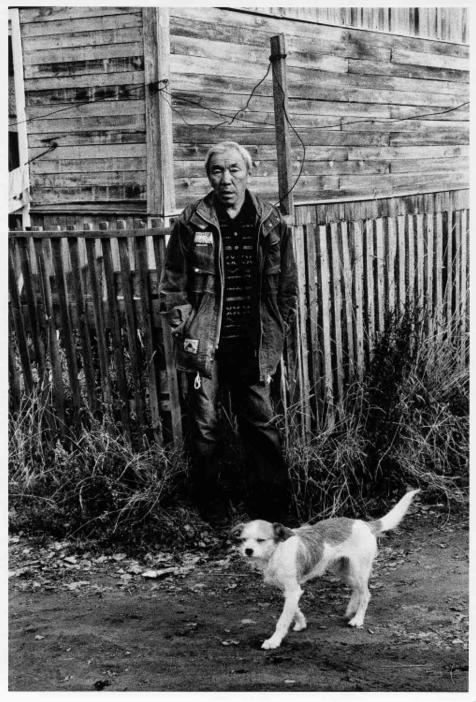「サハリン」 中藤毅彦

北海道の最北端、宗谷岬からわずか50キロに位置する島サハリン。現在はロシア連邦の一部だが、実に28もの様々な人種の人々が暮らす土地である。人口の大多数を占めるのはスラブ系の白人であるが、東洋系の顔立ちの人も多い。日本統治時代に移住し、戦後もそのまま帰れなかった朝鮮人、ニブヒ(ギリヤーク)、ウイルタ(オロッコ)などの北方民族、或は中央アジアや中国から移住したり出稼ぎに来ている人達だ。
サハリンは元来、少数の北方民族が住む辺境の島だったのだが、日本とロシアそれぞれの果てとも言える特異な地理条件にあった為、十九世紀初頭には様々な人種が混在して暮らすどの国家にも属さない土地となった。人間も風景も渾然としていたであろう当時の状況は現在のサハリンの姿とどこかで繋がる。
ここは、古くから北方民族の伝統的な暮らしは営まれていたものの、今に至るまで政治的に独立した事の無い土地であり時代が変化する度に住民の構成も変わって来た。それ故、外部から流れて来た人々を受け入れる懐の深さを持った土地なのであろう。
近代に入ってからは、日ロ両国の領土争いのせめぎ合いで都合3回も国境線が書き換えられ、その都度日本やアジア周辺の国々から人々が流入し、また望郷の念を抱きつつも去って行った。現在でも未だ地図上では戦前の日ロ国境が示されているという事実を見ても分かる様に辺境においては国境など常に流動的で曖昧な存在だ。線引きひとつで人生を左右され、いつ土地を追われ国を失う事になるかも知れない。だが、この様に政治的に不安定で不確かな場所だからこそ、この地の人々は国家のイデオロギーよりも自分たちが根を下ろしている土地への愛着と繋がりをより強く感じている様な気がしてならない。
今回の旅で訪れた鉄道で辿り着ける最北の街ノグリキは今、エネルギー開発の拠点として賑わい、中心部には高層アパートやスーパーも立ち並んでいる。だが、街はずれまで足を伸ばしてみると、そこには19世紀さながらの丸太小屋が連なるニブヒの人々が住む集落があった。時代から取り残された様なつつましい暮らしぶりであるが、彼らの表情には暗さは全くない。しぶとくしたたかに生きている様子だ。集落には小さな民族資料館も建ち、この土地の本来の住人として自分たちの伝統文化に強い誇りを持って暮らしている事が伺えた。
この写真はノグリキで出会ったニブヒの男性と愛犬である。
Sakhalin island is located 50 kilometers away from Cape Soya (Soya-Misaki) which is the northern end of Hokkaido. Currently it is a part of Russia, however, inhabitants on this island include as many as 28 different races. The majority of people is Slavic Caucasians, but many people have Oriental looks as well.
There are Korean immigrants who have migrated here during the time of Japanese ruling, Northern people like Nivkhi (Gilyak) or Uilta (Orok), there are also migrant workers from Central Asia and China.
Sakhalin was originally a remote region with a small number of population, most of them were Northern people, however, sinceits location is so remote both from Japan and Russia, various immigrants settled on this island by the early 19th century, sense of belonging to acountry seems to have vanished over time.
People and scenery must have been sporadic back then and one could easily sense that from the current scenery of Sakhalin even now. The land hosted traditional life styles of Northern people, however, it has never been politically independent, and the mixture of inhabitants has changed continuously over time. This is probably the reason why this land has always been open to accepting new immigrants.
In the modern era, the national border was changed 3 times due to conflict between Japan and Russia, and as a result many people from Japan as well as other parts of Asia came rushing in while others were forced to leave reluctantly. Even now, the Japan-Russia border indicated on the mapis that of pre-war; the border has never been solid and it will always be ambiguous. Chances are, their lives will be changed completely by the way the border line is drawn and they may lose their land or even their country.
However, perhaps because of this ambiguity, people on this island seem to have stronger sense of ideology, compared to other parts ofthe nation. I feel that this is because they have passionfor their land where they belong and have stronger sense of bonding with the land.
I have visited Nogliki, which is located in the mostfar north accessible by train. The city is currently blooming as an energy development base and its central area is crowded with high rise apartment complexes and supermarkets. However, once outside of the city, there are villages of Nivkhi people, consisting of log cabins as if it is still in 19th century.
Their modest living is far from the modern living, but you could not read any gloomy nature in their facial expressions.
"Wild and tough" is their way of living.
There is a museum of history and folklore in the village and I was able to feel their dignity in their own traditional cultureas the native inhabitants of this land.
The photo is a man and his dog that I met in Nogliki.
「Sakhalin」 Takehiko Nakafuji

北海道の最北端、宗谷岬からわずか50キロに位置する島サハリン。現在はロシア連邦の一部だが、実に28もの様々な人種の人々が暮らす土地である。人口の大多数を占めるのはスラブ系の白人であるが、東洋系の顔立ちの人も多い。日本統治時代に移住し、戦後もそのまま帰れなかった朝鮮人、ニブヒ(ギリヤーク)、ウイルタ(オロッコ)などの北方民族、或は中央アジアや中国から移住したり出稼ぎに来ている人達だ。
サハリンは元来、少数の北方民族が住む辺境の島だったのだが、日本とロシアそれぞれの果てとも言える特異な地理条件にあった為、十九世紀初頭には様々な人種が混在して暮らすどの国家にも属さない土地となった。人間も風景も渾然としていたであろう当時の状況は現在のサハリンの姿とどこかで繋がる。
ここは、古くから北方民族の伝統的な暮らしは営まれていたものの、今に至るまで政治的に独立した事の無い土地であり時代が変化する度に住民の構成も変わって来た。それ故、外部から流れて来た人々を受け入れる懐の深さを持った土地なのであろう。
近代に入ってからは、日ロ両国の領土争いのせめぎ合いで都合3回も国境線が書き換えられ、その都度日本やアジア周辺の国々から人々が流入し、また望郷の念を抱きつつも去って行った。現在でも未だ地図上では戦前の日ロ国境が示されているという事実を見ても分かる様に辺境においては国境など常に流動的で曖昧な存在だ。線引きひとつで人生を左右され、いつ土地を追われ国を失う事になるかも知れない。だが、この様に政治的に不安定で不確かな場所だからこそ、この地の人々は国家のイデオロギーよりも自分たちが根を下ろしている土地への愛着と繋がりをより強く感じている様な気がしてならない。
今回の旅で訪れた鉄道で辿り着ける最北の街ノグリキは今、エネルギー開発の拠点として賑わい、中心部には高層アパートやスーパーも立ち並んでいる。だが、街はずれまで足を伸ばしてみると、そこには19世紀さながらの丸太小屋が連なるニブヒの人々が住む集落があった。時代から取り残された様なつつましい暮らしぶりであるが、彼らの表情には暗さは全くない。しぶとくしたたかに生きている様子だ。集落には小さな民族資料館も建ち、この土地の本来の住人として自分たちの伝統文化に強い誇りを持って暮らしている事が伺えた。
この写真はノグリキで出会ったニブヒの男性と愛犬である。
Sakhalin island is located 50 kilometers away from Cape Soya (Soya-Misaki) which is the northern end of Hokkaido. Currently it is a part of Russia, however, inhabitants on this island include as many as 28 different races. The majority of people is Slavic Caucasians, but many people have Oriental looks as well.
There are Korean immigrants who have migrated here during the time of Japanese ruling, Northern people like Nivkhi (Gilyak) or Uilta (Orok), there are also migrant workers from Central Asia and China.
Sakhalin was originally a remote region with a small number of population, most of them were Northern people, however, sinceits location is so remote both from Japan and Russia, various immigrants settled on this island by the early 19th century, sense of belonging to acountry seems to have vanished over time.
People and scenery must have been sporadic back then and one could easily sense that from the current scenery of Sakhalin even now. The land hosted traditional life styles of Northern people, however, it has never been politically independent, and the mixture of inhabitants has changed continuously over time. This is probably the reason why this land has always been open to accepting new immigrants.
In the modern era, the national border was changed 3 times due to conflict between Japan and Russia, and as a result many people from Japan as well as other parts of Asia came rushing in while others were forced to leave reluctantly. Even now, the Japan-Russia border indicated on the mapis that of pre-war; the border has never been solid and it will always be ambiguous. Chances are, their lives will be changed completely by the way the border line is drawn and they may lose their land or even their country.
However, perhaps because of this ambiguity, people on this island seem to have stronger sense of ideology, compared to other parts ofthe nation. I feel that this is because they have passionfor their land where they belong and have stronger sense of bonding with the land.
I have visited Nogliki, which is located in the mostfar north accessible by train. The city is currently blooming as an energy development base and its central area is crowded with high rise apartment complexes and supermarkets. However, once outside of the city, there are villages of Nivkhi people, consisting of log cabins as if it is still in 19th century.
Their modest living is far from the modern living, but you could not read any gloomy nature in their facial expressions.
"Wild and tough" is their way of living.
There is a museum of history and folklore in the village and I was able to feel their dignity in their own traditional cultureas the native inhabitants of this land.
The photo is a man and his dog that I met in Nogliki.